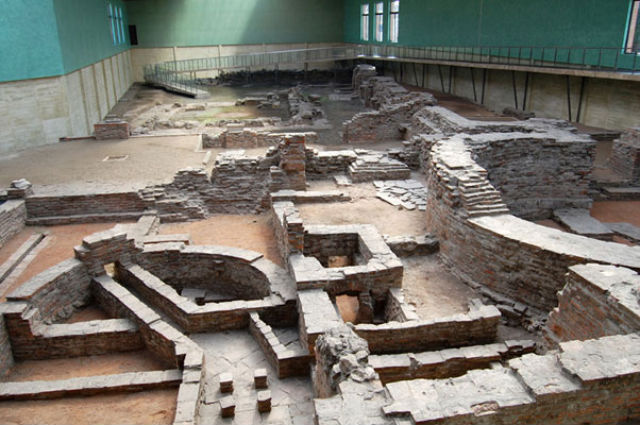Sirmium, one of the most important cities of the late Roman Empire, was located along the Sava River, in the area of today’s Sremska Mitrovica (Vojvodina). Founded in the 1st century, Sirmium was at the height of power in 294 when it was proclaimed one of the four capitals of the Roman Empire. The remains of the former rich and powerful ancient city of Sirmium, on an area of 2680 m2, were discovered under the streets of today’s Sremska Mitrovica, 55 km west of Belgrade.
The system of roads, aqueducts and military fortifications, remains of imperial palace, termi, theaters, hippodrome show that this city was the center (a legion camp, imperial city and a bishopric) of the whole area – the then Roman provinces of Pannonia. At the time, this was one of the important trading and transit centers of the Empire. Six Roman emperors were born in the city and its surroundings.

<a data-snax-placeholder="Source" class="snax-figure-source" href="https://sr.wikipedia.org/wiki/%D0%A1%D0%B8%D1%80%D0%BC%D0%B8%D1%98%D1%83%D0%BC" target="_blank" rel="nofollow noopener">https://sr.wikipedia.org/wiki/%D0%A1%D0%B8%D1%80%D0%BC%D0%B8%D1%98%D1%83%D0%BC</a>
The Romans conquered the Sirmium probably during the wars of Emperor Tiberius in Pannonia, between the ages of 13 and 9 before the new era, and during the reign of the Flavius dynasty, from the 69th to the 99th colonial status – Colonia Flavia Sirmium.Diocletian, in 294, proclaims it one of the four centers of the Roman Empire.
It was the starting point for military actions against groups of barbers, Huns, Goths and Gepids, who constantly attacked the border of this part of the Roman Empire. The name Sirmium means “river flow”, “running water”, “swamp” and is related to the position of the settlement on the nearby Sava River, according to the Latin name Savus.

<a data-snax-placeholder="Source" class="snax-figure-source" href="http://www.arheo-amateri.rs/2012/04/sirmium/" target="_blank" rel="nofollow noopener">http://www.arheo-amateri.rs/2012/04/sirmium/</a>
From the 1st to 3rd centuries in Sirmium, the Roman emperors Domitian, Marcus Aurelius, Septimus Severus, Maximinus Thrax, Claudius II Gothicus, Probus, Diocletian and the notorious imperials Ingenuus and Regalian lived in Sirmium for a short or longer period. Five Roman Emperors were born in Sirmium or its surroundings – Trajan Decius, Aurelian, Probus, Maximianus Herculius and Gratian.
The full glow of Sirmium is best seen in the 4th century remains, when the numerous inhabitants of Sirmium, Roman, Illyrian and Celtic descent, as well as immigrants from all parts of the great Roman Empire, enjoyed the privileges of life in such a mighty city that gave Roman imperatories. Soon, Sirmium becomes one of the most important early Christian centers, but also a place of Christian martyrs.Archaeological research in Sirmium, apart from the Imperial Palace and the neighboring amphitheater, uncovered numerous monumental public buildings, including the so-called Licinius Baths, the barn – horreum, and commercial and industrial parts. Luxuriously furnished urban buildings were discovered in Sirmium, as well as multi-storey buildings with apartments – insulae, where the less well-off parts of the population lived.

<a href="https://www.dreamstime.com/stock-photo-sirmium-imperial-palace-remains-powerful-beautiful-roman-city-image73893601" target="_blank" rel="noopener">Source</a>
An imposing building, about 450 meters long and about 150 meters wide, lies directly below the center of today’s city of Sremska Mitrovica and right next to the old Imperial Palace, which is the only known yet unexplored Roman hippodrome in the world. Between 316 and 324. Sirmium was protected by strong defensive walls and was supplied with water through aqueduct from the source Vranjesh in Frushka Gora. The money was wrought at Imperial Mint in Sirmium, while craft shops produced various items of precious metals, glass and ceramics. The Sirmium also rules brick.

<a data-snax-placeholder="Source" class="snax-figure-source" href="http://www.vojvodina.cafe/gallery.php?do=view_image&id=6594&gal=vcgallery" target="_blank" rel="nofollow noopener">http://www.vojvodina.cafe/gallery.php?do=view_image&id=6594&gal=vcgallery</a>
After 313, Sirmium became a significant Christian center of the Roman Empire. Dmitri of Mitrovica in Serbia was a soldier and a martyr, who was tormented by Emperor Meximian at the beginning of the 4th century.During the following centuries, Sirmium was under the control of numerous barbaric tribes – Gota, Hun, Avara, and by the end of the 8th century it probably belonged to the French state of Sarleman, while the area between the Danube and the Sava from 829 to 830 was under Bulgarian rule. Since the end of the 11th century, Sirmium has entered the field of interest of the Hungarian state. The struggle continued, with varying success, for more than 100 years, until 1180, when the Byzantine Emperor Manojlo I Komnen left the Srem area forever, leaving Sirmium to the young Hungarian country. The Kingdom of Hungary raises a new medieval city on the foundations of the ruined and once magnificent Sirmium. The city is named Civitas Sancti Demetrii (City of St. Dimitri), by city patron and in Sirmium the exiled Christian martyr Sv. Dimitriu. Hungarians have since been called Szávaszentdemeter and Serbs – Mitrovica. In 1396, it was destroyed for the first time, burned down and robbed by the Turks, who were taken into slavery by a section of the population. During the summer of 1521, Mitrovica finally fell under Turkish rule and remained in that state for nearly two centuries.




Interesting photos and I am glad measures are being taken to preserve these sites.
Excellent article , Thanks for sharing
Thank you very much for commenting Brankice.
Well done! Nice post!
Thank you very much for commenting.
Very interesting! I love history and there is so much to learn and sadly so much that has been twisted. Thank you for sharing.
Thank you very much for commenting.
Excellent article , Thanks for sharing
Thank you very much for commenting.
Excellently written about the historical period in Serbia.
A fascinating read. For a city where six Roman emperors were born, I never heard of this city in school.
Then again, our “education” system here sucks, because of the bureaucrats running it. They are all just self-serving dogs.
Serbia, and in general, the entire Balkans is a true treasury of history. It’s worth knowing something about us.
I believe you. Probably, because such knowledge could be valuable, is the reason our education system will not present it to our children here. All our government wants to produce is tax slaves and bodies to die for israel.